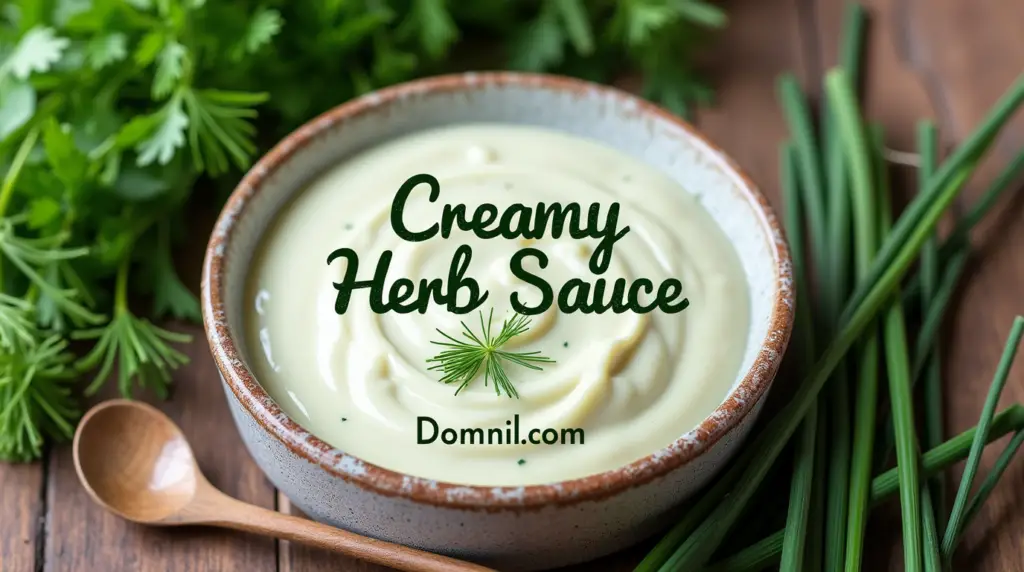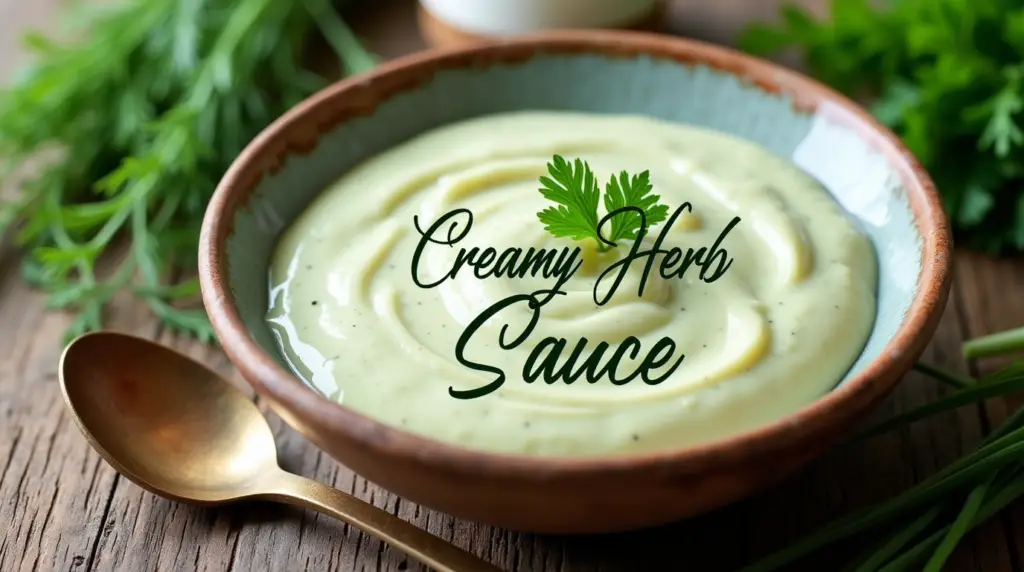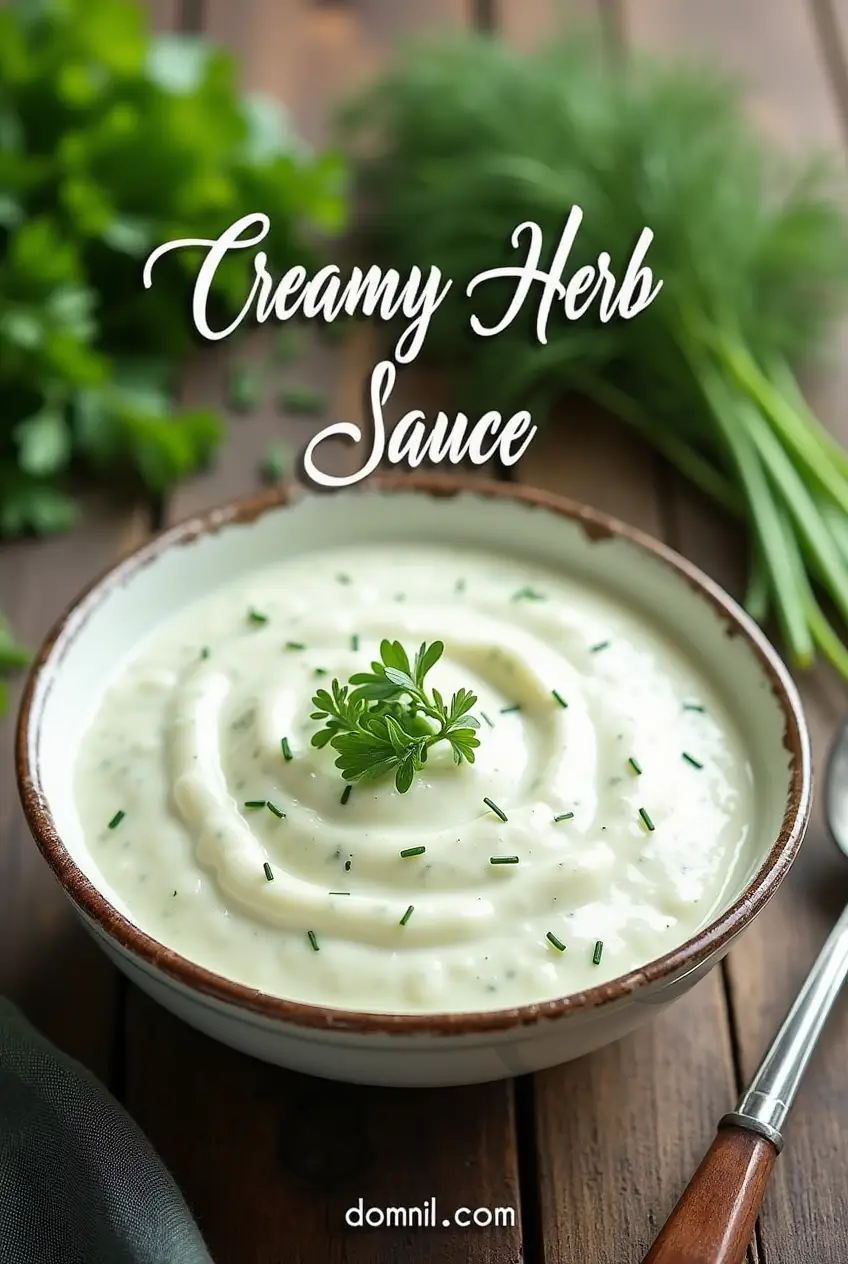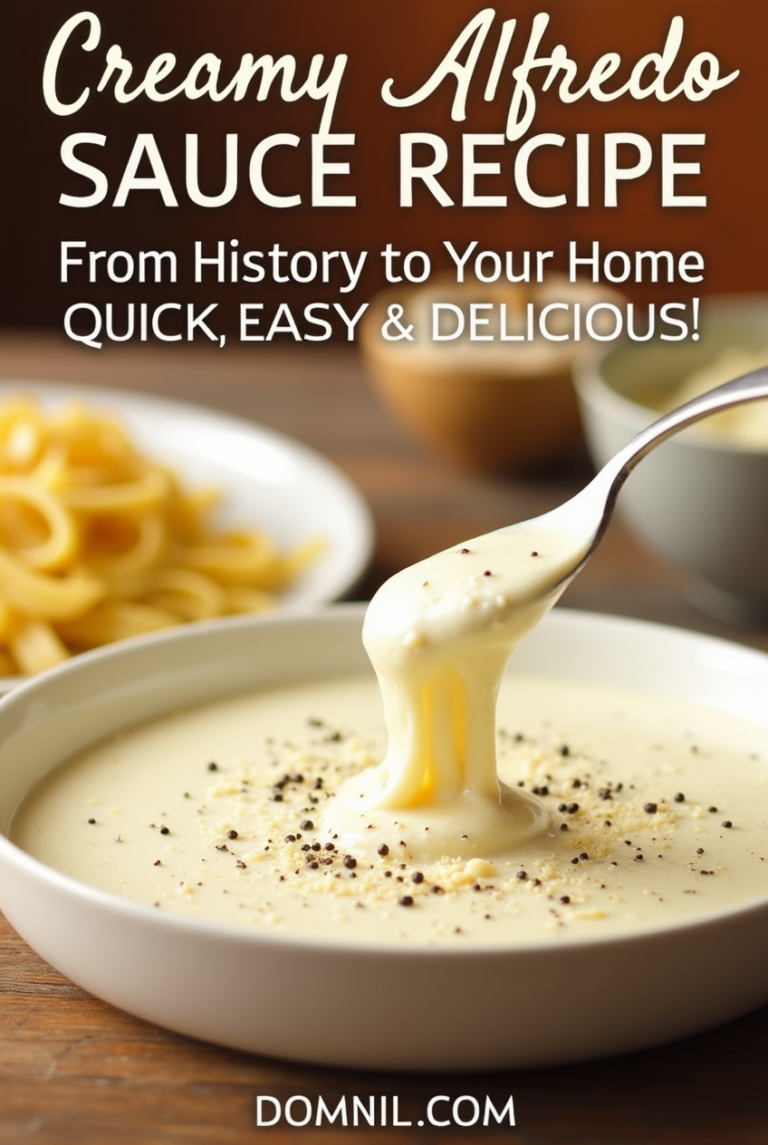Creamy Herb Sauce: Easy Recipe, Variations, and Best Pairings
Introduction to Creamy Herb Sauce
What Is Creamy Herb Sauce?
Creamy herb sauce is a luscious, velvety condiment crafted by blending fresh herbs with a rich, smooth dairy base. Whether you’re dressing up a pasta dish, drizzling over grilled chicken, or spooning it onto roasted veggies, this sauce is a flavor-packed powerhouse that enhances practically anything it touches. Imagine a fusion of garden-fresh herbs like parsley, dill, basil, and chives mixed into a creamy blend of butter, cream, or yogurt. That’s the heart and soul of creamy herb sauce—rich, aromatic, and delightfully versatile.
The beauty of creamy herb sauce lies in its balance. It’s indulgent, but the herbs keep it feeling light and fresh. You get a cool tang from the cream, a pop of brightness from the herbs, and an umami kick if you toss in a little garlic or cheese. It’s like a green goddess dressing and Alfredo sauce had a delicious baby. And yes, it’s just as magical as it sounds.

Why This Sauce Is a Must-Try
If you’ve never tried creamy herb sauce before, you’re seriously missing out. This sauce is like the secret weapon in every chef’s back pocket. It’s easy to make, requires minimal ingredients, and can instantly elevate a plain dish into something gourmet. Whether you’re hosting a dinner party or just trying to make leftovers more exciting, this sauce brings the flavor in spades.
Plus, it’s incredibly customizable. You can make it thick and cheesy for a pasta night or keep it light and zesty for a summer salad. It’s also a fantastic way to use up herbs that are sitting in your fridge. Don’t let that cilantro wilt into mush—blend it into something mouthwateringly delicious.
Essential Ingredients for Creamy Herb Sauce
Fresh Herbs That Make a Difference
Fresh herbs are the heartbeat of any good creamy herb sauce. While dried herbs can work in a pinch, they lack the bright, vibrant flavor that fresh herbs bring to the table. Here are the MVPs:
-
Parsley: A great base herb that adds freshness and color.
-
Dill: Perfect for a slightly tangy, cucumber-like flavor.
-
Basil: Sweet and aromatic, a must if you’re going Mediterranean.
-
Chives: Offers a mild onion flavor without the punch.
-
Cilantro: For a more global or Latin-inspired twist.
Mixing two or three herbs creates a depth of flavor that’s more interesting than sticking to just one. The key is to choose herbs that complement each other and don’t overpower the creamy base.
Always wash your herbs thoroughly and dry them completely before chopping. Wet herbs can water down your sauce and change its texture. Also, be generous! The more herbs you use, the more flavorful the result. Don’t just sprinkle them in—load them up.
Dairy Base Options: Cream, Yogurt, or Cheese
This is where your sauce gets its luxurious texture. You have a few options, depending on how rich you want the final product to be:
-
Heavy Cream: The classic choice for ultra-rich, indulgent sauces.
-
Greek Yogurt: A healthier, tangier option that adds protein.
-
Sour Cream: Offers a punchy tang with a thick texture.
-
Cream Cheese: Adds body and a mild sweetness.
-
Butter + Milk: A budget-friendly alternative that still works wonders.
The key is to balance richness with acidity. Too much cream and it might feel cloying. That’s where your lemon juice or vinegar comes in—just a splash can brighten the entire sauce.
If you’re feeling experimental, try mascarpone or even ricotta for a rustic touch. The possibilities are endless depending on your dietary preferences and the dish you’re pairing it with.
Spices and Flavor Enhancers
While herbs and cream are the stars, don’t forget the supporting cast—these ingredients deepen the flavor and make your sauce unforgettable:
-
Garlic: Raw for a pungent bite or roasted for sweetness.
-
Lemon juice or zest: Adds freshness and balances the fat.
-
Salt and pepper: Essential, but don’t overdo it—taste as you go.
-
Mustard (Dijon or whole grain): Adds a subtle kick and complexity.
-
Grated Parmesan: For umami and depth.
-
White wine or vinegar: A splash can add acidity and elegance.
These small additions may seem insignificant, but they can be the difference between a decent sauce and one that makes you want to lick the plate clean.

Step-by-Step Recipe for Creamy Herb Sauce
Basic Recipe for Beginners
Let’s start with a foolproof basic creamy herb sauce recipe that even a novice in the kitchen can whip up with confidence. You don’t need fancy tools or exotic ingredients—just a saucepan, a whisk, and your taste buds.
Ingredients:
-
1 cup heavy cream or half-and-half
-
1 tablespoon unsalted butter
-
1 garlic clove, minced
-
1/4 cup chopped fresh parsley
-
1/4 cup chopped fresh chives
-
2 tablespoons chopped dill or basil
-
1 teaspoon lemon juice
-
Salt and freshly ground black pepper to taste
Instructions:
-
In a medium saucepan, melt the butter over medium heat.
-
Add the minced garlic and sauté for about 1 minute until fragrant.
-
Slowly pour in the cream, stirring constantly. Bring to a gentle simmer.
-
Reduce the heat and let it simmer for 5–7 minutes, stirring frequently, until the sauce thickens slightly.
-
Stir in the chopped herbs, lemon juice, salt, and pepper.
-
Let it simmer for 1–2 more minutes, then remove from heat.
-
Taste and adjust seasoning if needed. Serve warm.
This version is light, fresh, and packed with herbaceous flavor. You can pour it over pasta, spoon it over chicken, or use it as a dipping sauce for roasted vegetables. It’s also a fantastic base if you want to get more creative later on.
Advanced Twist: Chef’s Special Version
Ready to step it up a notch? Here’s a richer, more decadent version that’s restaurant-quality and worthy of any gourmet dinner table.
Ingredients:
-
1 tablespoon olive oil
-
2 tablespoons shallots, finely minced
-
2 garlic cloves, minced
-
1/2 cup white wine
-
1 cup heavy cream
-
1/4 cup grated Parmesan cheese
-
1/4 cup chopped mixed fresh herbs (parsley, basil, tarragon, thyme)
-
1 teaspoon Dijon mustard
-
1/2 teaspoon lemon zest
-
Salt and black pepper to taste
Instructions:
-
Heat olive oil in a skillet over medium heat.
-
Add shallots and garlic; sauté until soft and translucent.
-
Deglaze the pan with white wine, scraping up any bits stuck to the bottom. Let it reduce by half.
-
Pour in the cream and bring it to a gentle boil, then reduce to a simmer.
-
Whisk in the Parmesan cheese and mustard.
-
Stir in the herbs and lemon zest. Simmer for another 2 minutes.
-
Season with salt and pepper. Serve hot.
This version is creamy, cheesy, and has a slight tang from the mustard and wine. It pairs incredibly well with seared salmon, grilled steak, or even gnocchi.
Common Mistakes and How to Avoid Them
Creamy herb sauce is simple, but a few common mistakes can ruin the texture or dull the flavor. Here’s what to avoid:
-
Overcooking the Cream: If your heat is too high, the cream can curdle or separate. Always simmer gently and stir frequently.
-
Using Dried Herbs at the Wrong Time: If you must use dried herbs, add them earlier in the cooking process to help them rehydrate and release flavor.
-
Underseasoning: Taste as you go and don’t forget the lemon juice or vinegar—it helps cut through the richness.
-
Overloading with Garlic: While garlic adds depth, too much can overwhelm the herbs. Stick to a clove or two.
-
Skipping the Acid: A splash of lemon juice, white wine, or vinegar is key to balancing out the fat. Don’t skip it!
Avoiding these mistakes ensures a sauce that’s smooth, flavorful, and worthy of serving to guests or just treating yourself.
Variations of Creamy Herb Sauce
Vegan and Dairy-Free Options
For those avoiding dairy, there’s no need to miss out on creamy herb goodness. With a few smart swaps, you can create a luscious vegan version that rivals the original.
Ingredients:
-
1 cup unsweetened coconut cream or cashew cream
-
1 tablespoon olive oil or vegan butter
-
1 garlic clove, minced
-
1/4 cup nutritional yeast (for cheesy flavor)
-
1/4 cup chopped fresh herbs (parsley, basil, cilantro)
-
1 teaspoon lemon juice
-
Salt and pepper to taste
Instructions:
-
Sauté garlic in olive oil until fragrant.
-
Add coconut cream and simmer for 5–7 minutes.
-
Stir in nutritional yeast and herbs.
-
Add lemon juice, salt, and pepper.
-
Simmer for 1–2 more minutes and serve.
This version is just as versatile and offers a dairy-free indulgence that works well for pasta, grains, or veggie bowls.

Spicy Herb Sauce for Heat Lovers
Like a little kick? Add some spice to your creamy herb sauce to wake up your taste buds.
Spice Options:
-
Red pepper flakes
-
Minced jalapeños
-
Sriracha or hot sauce
-
Smoked paprika
-
Cayenne pepper
Use spice in moderation. The key is to enhance—not overpower—the herbal freshness and creamy texture. A pinch of cayenne or a swirl of Sriracha can transform the sauce into something bold and unforgettable.
Mediterranean-Style Creamy Herb Sauce
For a Mediterranean flair, opt for herbs like oregano, basil, and mint. Swap in Greek yogurt for the base and add garlic, lemon, and a touch of feta.
Ingredients:
-
1 cup Greek yogurt
-
1 garlic clove
-
1/4 cup fresh oregano and mint, chopped
-
2 tablespoons crumbled feta
-
Juice of half a lemon
-
Salt and pepper to taste
Blend all ingredients together for a refreshing, tangy sauce that’s perfect for falafel, grilled lamb, or pita sandwiches.
Best Dishes to Pair with Creamy Herb Sauce
Pasta and Noodles
One of the most divine ways to enjoy creamy herb sauce is over a steaming bowl of pasta. The sauce clings beautifully to the strands of fettuccine, penne, or spaghetti, enveloping each bite in velvety, herby goodness. It’s a match made in carb heaven. Whether you’re making a quick weeknight dinner or a romantic candlelit meal, this sauce transforms a humble bowl of noodles into something luxurious and restaurant-worthy.
To create the ultimate creamy herb pasta, toss freshly cooked pasta directly into the warm sauce while it’s still on the stove. Let the noodles soak up the flavor for a minute or two before serving. Don’t forget to reserve a bit of the pasta water—adding a splash can loosen the sauce and help it cling better.
For added texture and flavor, you can stir in:
-
Grilled or shredded chicken
-
Sautéed mushrooms
-
Sun-dried tomatoes
-
Spinach or arugula
-
Crumbled feta or goat cheese
Even better, you can use this sauce as a baked pasta topping. Mix it with al dente rigatoni, top with cheese, and bake until bubbly and golden.
Grilled Meats and Seafood
Few sauces complement grilled meats and seafood like creamy herb sauce. The herbs enhance the smokiness of grilled proteins, while the creaminess adds a decadent finish that’s hard to resist. It’s a fantastic alternative to chimichurri, barbecue sauce, or lemon butter.
Here’s how to pair it right:
-
Grilled Chicken: The herbs uplift the mild flavor of chicken, especially when served over a sliced grilled breast or thigh.
-
Steak: A drizzle over sliced flank steak or filet mignon adds elegance and bold flavor.
-
Salmon: Creamy dill sauce and salmon are a legendary pairing. The sauce cuts the richness of the fish and adds a tangy herb layer.
-
Shrimp and Scallops: Quick to cook and quick to wow—just spoon the sauce over seared seafood and watch it disappear.
For BBQ season, serve this sauce cold or at room temperature as a dipping sauce alongside kebabs, ribs, or grilled sausages.
Vegetables and Roasted Potatoes
Vegetarians and veggie-lovers rejoice—creamy herb sauce is just as incredible on vegetables. It elevates roasted potatoes to a whole new level and turns bland steamed veggies into a gourmet side dish.
Here’s how to use it:
-
Roasted Potatoes: Drizzle or toss with roasted baby potatoes, russets, or sweet potatoes.
-
Grilled or Roasted Veggies: Works beautifully with asparagus, zucchini, carrots, and bell peppers.
-
Steamed Greens: Pour over steamed broccoli, green beans, or cauliflower for extra flavor.
-
Buddha Bowls: Use as a finishing touch over grain bowls with quinoa, beans, and fresh veggies.
You can also use it as a dip for crudités, a sauce for veggie burgers, or even as a topping for baked sweet potatoes. It’s a flavor amplifier that makes healthy eating something to look forward to.
Tips for Storing and Reheating
Fridge Storage Techniques
After making a delicious batch of creamy herb sauce, you might find yourself with leftovers. Good news: this sauce stores like a dream if you handle it correctly. To keep it fresh and flavorful, store it in an airtight glass or plastic container with a tight-fitting lid.
Pro tips:
-
Let the sauce cool to room temperature before sealing and refrigerating.
-
Label the container with the date so you remember when it was made.
-
Use within 4 to 5 days for the best quality and taste.
If your sauce thickens in the fridge, that’s totally normal. Just stir in a teaspoon of milk or water when reheating to bring it back to life.
Freezing Tips Without Losing Flavor
Creamy sauces can be tricky to freeze because dairy has a tendency to separate when thawed. However, with the right approach, it’s totally doable.
Here’s how:
-
Use heavy cream or full-fat yogurt as your base—low-fat versions tend to separate more.
-
Portion the sauce into small containers or ice cube trays for convenience.
-
Wrap tightly and place in a freezer-safe container or resealable bag.
When you’re ready to use it, thaw in the fridge overnight and reheat gently over low heat while whisking. If it separates slightly, add a bit of fresh cream or whisk vigorously to bring it back together.
Reheating Without Curdling the Sauce
Nobody wants a clumpy or curdled sauce. The key to reheating creamy herb sauce is to do it slowly and gently.
Here’s the method:
-
Warm it in a saucepan over low heat.
-
Stir constantly to maintain a smooth texture.
-
Add a splash of milk, cream, or even pasta water to thin it out.
-
Avoid microwaving if possible, as it heats unevenly and can cause separation.
If you must use the microwave, heat it in 20–30 second intervals, stirring in between to maintain a uniform texture. A little patience goes a long way in preserving that creamy, dreamy consistency.
Nutritional Value and Health Benefits
Calories and Macronutrient Breakdown
Creamy herb sauce may seem indulgent, but when made mindfully, it can be a nutritious addition to your meals. Let’s break it down. A standard serving (about 2 tablespoons) of traditional creamy herb sauce made with heavy cream, butter, and herbs typically contains:
-
Calories: 90–120
-
Fat: 8–10 grams
-
Protein: 1–2 grams
-
Carbohydrates: 1–2 grams
-
Sugar: 0–1 gram
Using lighter bases like Greek yogurt or plant-based alternatives can significantly reduce calories and fat while boosting protein content. For example, a Greek yogurt-based version might clock in at only 40–50 calories per serving, with half the fat and double the protein.
It’s all about what ingredients you choose and how you balance them. Want to lighten it up even more? Go for low-fat Greek yogurt or blend cashews with water for a creamy, non-dairy base.
How Herbs Support Health
Beyond flavor, the herbs in this sauce offer a bounty of health benefits. These aren’t just green specks for show—they’re nutrient-dense powerhouses. Let’s take a closer look:
-
Parsley: Rich in vitamin K, vitamin C, and antioxidants, it supports bone health and immune function.
-
Basil: Contains eugenol and essential oils with anti-inflammatory properties.
-
Dill: Offers antimicrobial benefits and aids digestion.
-
Cilantro: Helps detoxify heavy metals and is packed with vitamins A and K.
-
Chives: A mild source of sulfur compounds, good for heart health.
So, while you’re enjoying the creamy texture, you’re also giving your body a boost. It’s indulgence with benefits.
Lightening the Sauce Without Losing Flavor
Want the flavor without the extra calories? No problem. There are several easy tweaks you can make to create a lighter, healthier version that still satisfies your creamy cravings:
Swap Suggestions:
-
Replace heavy cream with low-fat Greek yogurt or silken tofu.
-
Use olive oil instead of butter for a heart-healthier fat.
-
Incorporate lemon juice or vinegar for brightness instead of relying on rich cheese or cream.
-
Cut back on salt by adding umami through ingredients like garlic, mustard, or nutritional yeast.
You can also add a splash of vegetable broth to thin the sauce and make it more pourable without sacrificing flavor. A little creativity goes a long way here, and these changes make the sauce more suitable for daily use—not just special occasions.
Homemade vs Store-Bought: The Big Debate
Cost Comparison
At first glance, grabbing a bottle of pre-made creamy herb sauce from the grocery store might seem like a time-saver. But when it comes to cost, making it at home almost always wins. Let’s compare:
-
Store-bought (8 oz): $4–$7
-
Homemade (8 oz): Roughly $2–$3 depending on ingredients
Plus, when you make it yourself, you’re not paying extra for packaging, preservatives, and brand names. You’re getting more value, better quality, and full control over what goes into your food.
Taste and Freshness
There’s just no comparison between fresh and pre-made when it comes to flavor. Homemade creamy herb sauce is vibrant, aromatic, and tailored exactly to your taste buds. You control the herbs, the tang, the creaminess, and the texture. Store-bought versions, on the other hand, often rely on stabilizers and artificial flavors to mimic freshness.
Want that freshly chopped parsley zing? You won’t get that from a jar that’s been sitting on a shelf for six months.
Ingredients Transparency
One of the biggest advantages of making your own creamy herb sauce is knowing exactly what you’re eating. Store-bought sauces often include:
-
Preservatives like sodium benzoate
-
Artificial thickeners like xanthan gum
-
High sodium content
-
Hidden sugars or sweeteners
When you go homemade, it’s clean eating at its best. You can choose organic herbs, skip the salt, go dairy-free—whatever suits your diet or lifestyle. It’s real food, with real ingredients, made by you.
Essential Tools to Prepare Creamy Herb Sauce
Making creamy herb sauce is simple, but having the right tools makes the process smoother and ensures your sauce turns out perfectly every time. You don’t need a professional kitchen setup—just a few basic, reliable tools will do the trick.
1. Saucepan or Small Pot
A heavy-bottomed saucepan is essential for cooking the base of your sauce. It ensures even heat distribution and prevents the cream from scorching or curdling. Look for a non-stick or stainless-steel version with a sturdy handle for easy maneuvering.
2. Whisk
A whisk is your best friend when making creamy sauces. It helps blend the cream, herbs, and other ingredients into a smooth, consistent texture. Choose a balloon whisk for maximum air and fluid mixing or a flat whisk for working close to the bottom of the pan.
3. Cutting Board and Sharp Knife
Fresh herbs are the star of the show, and you’ll need a sharp knife and cutting board to chop them finely. A dull knife will bruise the herbs rather than slice them cleanly, which can affect both flavor and presentation.
4. Measuring Cups and Spoons
Accuracy matters when you’re balancing cream, acid, and herbs. Measuring tools help you maintain the right proportions, especially when working with strong flavors like mustard or lemon juice.
5. Garlic Press or Microplane (Optional)
To intensify the garlic flavor, consider using a garlic press or a microplane grater. These tools extract more juice and create a finer texture than chopping alone, which blends more seamlessly into the sauce.
6. Blender or Food Processor (For Smooth Versions)
If you want an ultra-smooth sauce (especially for vegan versions made with nuts or tofu), a blender or food processor will help you achieve that restaurant-quality silkiness. It’s also ideal for emulsifying thicker or chunkier ingredients.
7. Fine Mesh Strainer (Optional)
If you’re going for a more refined, delicate texture, strain your sauce through a fine mesh sieve. This removes herb bits, garlic chunks, and any other solids, resulting in a velvety finish.
8. Storage Containers
After making your sauce, you’ll need airtight containers for storing leftovers. Glass jars or BPA-free plastic containers with tight lids are perfect for keeping the sauce fresh in the fridge or freezer.
9. Spatula or Wooden Spoon
To stir the sauce as it simmers and scrape down the sides of the pot, a heat-safe spatula or wooden spoon is ideal. These tools give you control without scratching your cookware.
Optional but Helpful Extras:
-
Immersion Blender: For quick blending directly in the saucepan.
-
Herb Scissors: To snip herbs finely and evenly without bruising.
-
Citrus Juicer or Zester: To easily extract juice or zest from lemons and limes.
With these tools in your kitchen, you’ll be fully equipped to create a creamy herb sauce that’s smooth, flavorful, and absolutely irresistible.
Popular Questions About Creamy Herb Sauce
Can It Be Made Ahead of Time?
Absolutely! Creamy herb sauce can be made up to 3–5 days in advance. In fact, some people swear it tastes even better the next day after the flavors have had time to meld. Store it in a tightly sealed container in the fridge and just reheat gently when ready to serve.
For convenience, you can also freeze it in portion-sized containers or ice cube trays. Perfect for meal prep!
Is It Safe for Kids and Toddlers?
Yes, as long as you use fresh ingredients and go easy on the salt and garlic, creamy herb sauce is a kid-friendly option. It’s a great way to sneak more herbs and nutrients into their meals. Try it on pasta, mashed potatoes, or steamed veggies for a toddler-approved dish.
For extra safety, skip spicy add-ins like cayenne or hot sauce when serving to little ones.
How Long Does It Last in the Fridge?
Homemade creamy herb sauce should be stored in an airtight container in the refrigerator and used within 4 to 5 days. Always check for signs of spoilage—such as a sour smell or discoloration—before using.
If you’re unsure, remember this golden rule: when in doubt, throw it out.
Conclusion
Creamy herb sauce is more than just a condiment—it’s a kitchen essential that can elevate everyday meals into gourmet experiences. From its versatile base of cream or yogurt to the vibrant punch of fresh herbs, it’s a flavor bomb that adapts to your mood, dietary preferences, and whatever ingredients you have on hand. Whether you’re a die-hard foodie or just someone who wants to add more taste to your plate, this sauce has got your back.
Homemade is where it’s at. It’s fresher, healthier, more economical, and endlessly customizable. So next time you’re staring at a plain chicken breast or a boring bowl of rice, remember: a spoonful of creamy herb sauce is all it takes to turn “meh” into “marvelous.”
FAQs
1. What herbs are best for creamy herb sauce?
Parsley, chives, dill, basil, and cilantro are excellent choices. Mixing two or three gives you the best flavor complexity.
2. Can I use dried herbs instead of fresh?
Yes, but use about one-third the amount. Dried herbs are more concentrated, and they should be added earlier in the cooking process.
3. How do I thicken my creamy herb sauce?
Simmer it longer, or whisk in a teaspoon of flour, cornstarch, or cream cheese. For a non-dairy version, blended cashews or tofu work well.
4. Is this sauce gluten-free?
Yes, as long as you don’t add flour or use any gluten-containing thickeners. Most homemade versions are naturally gluten-free.
5. Can I use almond milk or soy milk as a substitute?
You can, but the texture will be lighter. Use full-fat versions for better results, and consider adding a thickener like nutritional yeast or blended nuts for creaminess.




